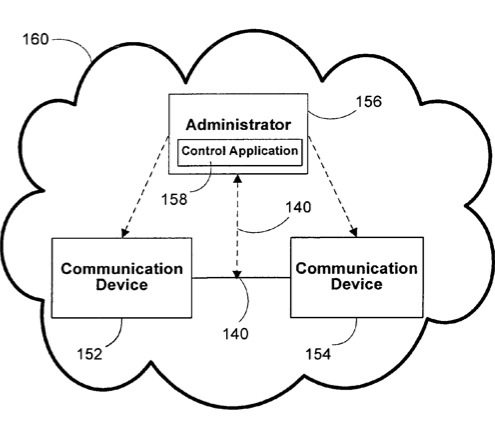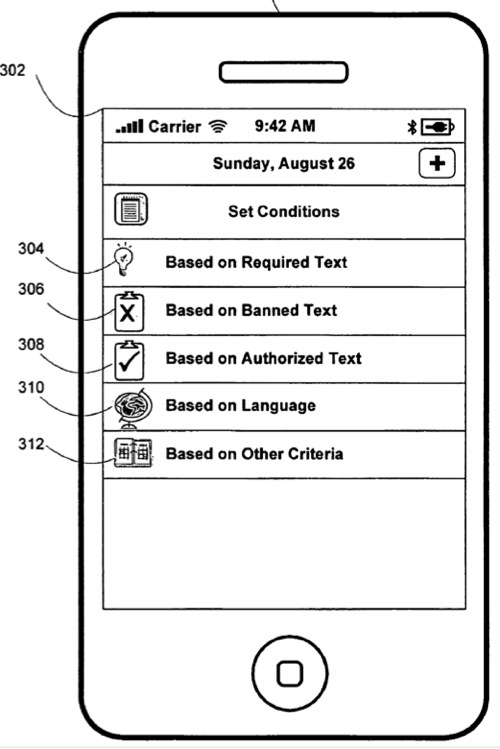The US Patent and Trademark Office has awarded Apple a patent (number 7814163) first filed in 2008 that prevents users from sending or receiving “inappropriate” text messages. The patent is for "text-based communication control for a personal communications device."
According to Apple, systems, devices, and methods are provided for enabling a user to control the content of text-based messages sent to or received from an administered device. In some embodiments, a message will be blocked (incoming or outgoing) if the message includes forbidden content. In other embodiments, the objectionable content is removed from the message prior to transmission or as part of the receiving process. The content of such a message is controlled by filtering the message based on defined criteria. The criteria may be defined according to a parental control application. These techniques also may be used, in accordance with instructional embodiments, to require the administered devices to include certain text in messages. These embodiments might, for example, require that a certain number of Spanish words per day be included in e-mails for a child learning Spanish. The inventor is Michael M. Lee.
Here's Apple's background and summary of the invention: "This relates to text-based communication devices. The proliferation of computers and compact portable devices has led to vast amounts of text-based communication. One problem with text-based communications is that there is no way to monitor and control text communications to make them user appropriate. For example, users such as children may send or receive messages (intentionally or not) with parentally objectionable language. Also, because electronic text-based messaging often can be informal, some users may draft messages that are grammatically incorrect.
"One way in which parental control can be accomplished is to limit the access points that a user can have. For example, a parent could prevent a child user from accessing specific websites, or limit the user to communicating electronically with a limited set of individuals or e-mail addresses. Such solutions, however, still do not address the content of the communications that the child user has with the permitted communicators.
"One way that systems can be used to attempt to control the content that a user can view is to pass all of the communications through a dictionary which prevents a given set of words from being communicated. For example, many such dictionaries, if selected, typically prevent the user from sending or receiving curse words. One problem with this potential solution is that the dictionaries are often fixed. Another potential problem with such dictionaries is that they do not have the ability to prevent the use of non-standard forms of words from being communicated, such as those types of words that are often communicated via text messaging (such as, for example, text messaging 'LOL' instead of typing out the full text of 'lots of luck').
"The invention, in various embodiments, addresses deficiencies in existing attempts at solutions by providing systems, methods and devices that enable an administrator to control the text-based communications of a user of a text-based communications device through an administrative mode of an intelligent text-based communication control unit or application. The text-based communication control application filters incoming and/or outgoing text-based communications based on administrator-defined criteria.
"In one embodiment, the control application includes a parental control application. The parental control application evaluates whether or not the communication contains approved text based on, for example, objective ratings criteria or a user's age or grade level, and, if unauthorized, prevents such text from being included in the text-based communication. If the control contains unauthorized text, the control application may alert the user, the administrator or other designated individuals of the presence of such text. The control application may require the user to replace the unauthorized text or may automatically delete the text or the entire communication.
"In another embodiment, the control application includes an instructional tool or study aid where the administrator sets one or more modes, such as language, vocabulary, grammar, spelling, punctuation and/or other content of a text-based communication based on, for example, a user's age or grade level. This can be especially useful, for example, such as when a child's grades go down. A parent can then institute a condition to improve a child's grades. For example, the control application may require a user during specified time periods to send messages in a designated foreign language, to include certain designated vocabulary words, or to use proper designated spelling, designated grammar and designated punctuation and like designated language forms based on the user's defined skill level and/or designated language skill rating. If the text-based communication fails to include the required language or format, the control application may alert the user and/or the administrator/parent of the absence of such text.
"The control application may require the user to rewrite the text-based communication in the required language, to include the required vocabulary words and/or to correct spelling and punctuation errors. The control application may require the user to locate the error. If the user cannot correct the error, the control application may provide hints as to the location of the error by first indicating the paragraph, then, the line and, finally, the exact location.
"In some embodiments, a text-based communication device includes a user interface that enables a user to perform at least one of inputting and editing a message. The device also includes a transmitter for sending the message. The device further includes a processor that controls the sending of the message based on a portion of the message and one or more message control conditions.
"In some embodiments, the message control conditions include at least one of required text, banned text, authorized text and designated language. In other embodiments, the device includes a data storage that include at least one of a number of required text words, a number of banned text words, a number of of authorized text words, and a number of designated language forms.
"In still other embodiments, controlling includes comparing a portion of the message with the stored data to determine whether the communication satisfies one or more message control conditions. In these instances, controlling may also include: (i) preventing the sending of the message if the message does not satisfy one or more message control conditions; or (ii) allowing the message to be sent if the message satisfies all of the message control conditions. Controlling may further include prompting the user to modify the message if the message does not satisfy one of the message control conditions.
"In some embodiments, at least one of the message control conditions includes applying ratings to the message control conditions, at least one of which can correspond to the user's designated language skill rating. The rated message control conditions can be applied to the entire message or a portion of the message according to the user's designated language skill rating. In further embodiments, the designated language may include a required foreign language, vocabulary, spelling, grammar and/or punctuation based on the user's designated skill level.
"In other embodiments, a text-based communication device includes a user interface that enables a user to view a message, a receiver that receives the message from a sender, and a processor that controls the receiving of the message based on a portion of the message and one or more message control conditions.
"In yet other embodiments, a communications system includes a first communication device that performs at least one of sending and receiving a message. The communications system also includes an administrator unit that performs at least one of controlling the sending of the message and the receiving of the message based on message control conditions. The message control conditions may include rated message control conditions where at least one of the rated message control conditions corresponds to a designated language skill level of a user of the first communication devices. In certain embodiments, the controlling function includes at least one of: (i) preventing the sending or receiving of the message if the message does not satisfy the rated message control conditions corresponding to the user's designated language skill rating; and (ii) allowing the sending or receiving of the message if the message satisfies all of the rated message control conditions corresponding to the user's designated language skill rating.
"While the above was described with respect to one or more various embodiments, persons skilled in the art will appreciate that the features described herein with respect to one or more embodiments can be combined together without departing from the spirit of the present invention."
-- Dennis Sellers














